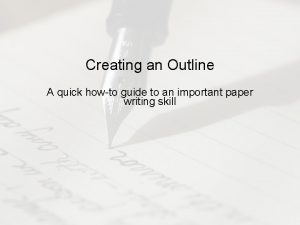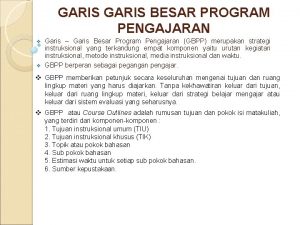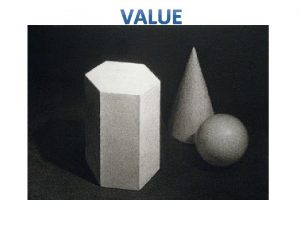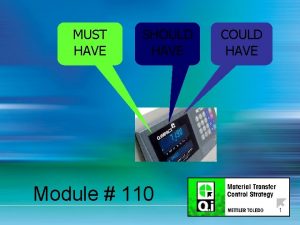Outlines Your outline should have four or five










- Slides: 10

Outlines • Your outline should have four or five parts: – Summary – If necessary, description of channel – Comments – Personal Narrative – Evaluation • Your essay should move from an objective description of the video to your own judgement. Your own judgement should not appear until the evaluation.

Outlines • Summary – You need to identify the parts of the video. Each part will most likely have a paragraph. – The parts do not correspond to steps in the instructions (for example, the beginning of the video is not a step). – The subjects of the topic sentences should be the video or the name of a character in the video. The subjects of the sentences in this summary should never be “you. ” Verbs should not be in the imperative mood (do not give commands in your summary).

Outlines • Summary – “The video begins…” would be an appropriate beginning for your summary. – “After [videomaker] presents the ingredients, she starts…” would be an appropriate transition.

Outlines • Comments – One paragraph should give an overview of the comments – The most important comments are from people who tried to use the video. – One paragraph should contain questions and/or criticisms. Responses from the videomaker are important. – You might need a paragraph about other comments if they are relevant to your evaluation.

Outlines • Comments – It will be helpful for you to copy and paste the comments into your outline. Eventually you will use direct quotations.

Outlines • Personal Narrative – The personal narrative should retell events and your verbs should be in past tenses. Your opinion in the present should not appear in the personal narrative. If you formed opinions during the time of the narrative the opinions might be relevant as long as they are put into the past. – The personal narrative should be in chronological order.

Outlines • Personal Narrative – At the beginning of the personal narrative you should describe how you became interested in your topic and in using the video.

Outlines • Evaluation – Your evaluation should be drawn from comments and from your own experience. – You should have a clear idea about the criteria (the rubric) that you are using to judge the video. – Your evaluation should indicate how someone who is interested in the video should use the video.

Outlines • Evaluation – Your evaluation should give suggestions to the videomaker for improving the video (objections) and/or identify audiences that would find the video the most useful and audiences who should try to find other videos or resources (limitations).

Outlines • Quick rubric – Outline, not a draft – Sequence of paragraphs visible – Summary is not a set of instructions – Summary covers the whole video – Comments part of the outline includes people who have tried to use the video and questions – Personal narrative has a setting and a marker for time – Evaluation accounts for questions and criticisms
 Four main components for effective outlines
Four main components for effective outlines Five years have past five summers with the length
Five years have past five summers with the length Perfect modals examples
Perfect modals examples Could + past tense
Could + past tense Some animals are dangerous *
Some animals are dangerous * Subordination outline example
Subordination outline example Teaching outline
Teaching outline Kairos program manual
Kairos program manual Commercial law outlines
Commercial law outlines A business plan is a document that outlines
A business plan is a document that outlines Benign nephrosclerosis pathology outlines
Benign nephrosclerosis pathology outlines



















